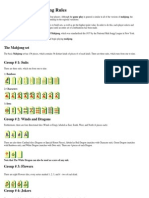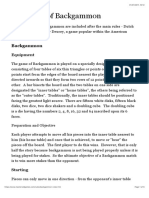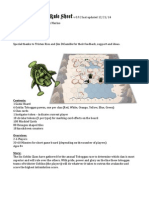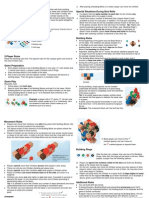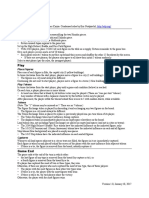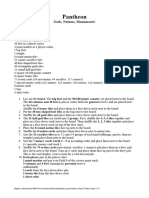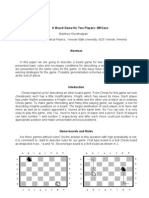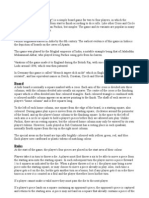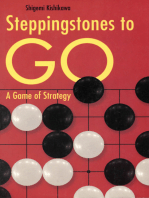0 ratings0% found this document useful (0 votes)
36 viewsChinese Checkers: Adapted For The Piecepack by Mark A. Biggar
Chinese Checkers: Adapted For The Piecepack by Mark A. Biggar
Uploaded by
arteepu4Cc
Copyright:
© All Rights Reserved
Available Formats
Download as PDF, TXT or read online from Scribd
Chinese Checkers: Adapted For The Piecepack by Mark A. Biggar
Chinese Checkers: Adapted For The Piecepack by Mark A. Biggar
Uploaded by
arteepu40 ratings0% found this document useful (0 votes)
36 views3 pagesCc
Original Title
Cc
Copyright
© © All Rights Reserved
Available Formats
PDF, TXT or read online from Scribd
Share this document
Did you find this document useful?
Is this content inappropriate?
Cc
Copyright:
© All Rights Reserved
Available Formats
Download as PDF, TXT or read online from Scribd
Download as pdf or txt
0 ratings0% found this document useful (0 votes)
36 views3 pagesChinese Checkers: Adapted For The Piecepack by Mark A. Biggar
Chinese Checkers: Adapted For The Piecepack by Mark A. Biggar
Uploaded by
arteepu4Cc
Copyright:
© All Rights Reserved
Available Formats
Download as PDF, TXT or read online from Scribd
Download as pdf or txt
You are on page 1of 3
Chinese Checkers
Adapted for the piecepack by Mark A. Biggar
Version 1.1, July 2004
Copyright 2004, Mark A. Biggar
2 or 4 players - 30 min
Object
To move all your pieces across the board to your opposite opponents starting
position. This is the classic game Chinese Checkers adapted for play on a
square board.
Four Player Game Setup
Give each player the six coins of the same color. Use 16 tiles grid-side up to
construct an 8x8 square board as shown in figure 1 below. Each player places
his coins suit-side up in one corner of the board as shown below (the colors in
the figure are for example only.) Choose a starting player by any method of the
players choice.
Figure 1. Starting Setup.
The Rules of Play
Each players turn consists of making one of two types of moves: a
player may either move a single coin to any adjacent empty square in
any of the eight directions or make a series of jump moves with a
single coin. If a players coin is adjacent to any other coin (belonging
to any player including his own) and the square on the other side of the
adjacent coin is empty, then the player can jump his coin over the
adjacent coin into the empty square. The player may continue making
jumps with that coin as many times as he wishes, but the coin must
end up in a different square then it started. A player is not forced to
make any jump move after the first. Jumps may also be made in any
of the eight directions and each jump may be in a different direction.
After making a series of jumps or moving one square, the players turn
is done. Players may not pass. Play then passes clockwise to the
next player around the table.
Winning
A player wins when, after moving a coin, all six of the players coins
occupy the starting positions of the coins of that started in the opposite
corner.
Rules for two players
The rules for two players are the same as for four players except use
the 10 tile board and coin setup as shown in the following figure.
. Figure 2. Two Player Starting Setup.
Design Notes
1. The classic game uses a hexagonal grid, which of course is hard with a
piecepack. This resulted in the necessity to use all eight directions both
orthogonal and diagonal to free things up. Otherwise, if only orthogonal
moves are allowed, the pieces get too clogged up in the middle of the
board and the game bogs down.
2. The two player limited board makes for a good two player
abstract.
History
20040315 mab 1.0 www.piecepack.org version
20040729 mab 1.1 added design notes.
Thank you for playing my game. Please report rules problems or
variant suggestions to mark@biggar.org.
Copyright 2004 by Mark A. Biggar. Permission is granted to copy, distribute
and/or modify this document under the terms of the GNU Free Documentation
License, Version 1.2 or any later version published by the Free Software
Foundation; with no Invariant Sections, no Front-Cover Texts, and no Back-Cover
Texts. A copy of the license can be found at http://www.gnu.org/licenses/fdl.html.
You might also like
- American Mahjong RulesDocument6 pagesAmerican Mahjong RulesKarelBRG100% (2)
- ALHAMBRA Expansion SummaryDocument9 pagesALHAMBRA Expansion SummaryRon Van 't VeerNo ratings yet
- The Rules of BackgammonDocument6 pagesThe Rules of Backgammonlsi12No ratings yet
- Goblin Toboggan Rule Sheet - 12-24-14Document12 pagesGoblin Toboggan Rule Sheet - 12-24-14api-257004894No ratings yet
- Game 365 GameRulesDocument8 pagesGame 365 GameRuleslancelot54No ratings yet
- Turmbauer EnglishDocument3 pagesTurmbauer EnglishFerenc HuseNo ratings yet
- SamuraiDocument1 pageSamuraiperenetreNo ratings yet
- Pantheon English V 1 01Document12 pagesPantheon English V 1 01Panagiotis PavlidisNo ratings yet
- G G G G XXXX Üüüü Üüüü TTTT ' ' ' ' ÇÇÇÇ Áááá Àààà - VVVV TTTTDocument5 pagesG G G G XXXX Üüüü Üüüü TTTT ' ' ' ' ÇÇÇÇ Áááá Àààà - VVVV TTTTSebastian Alejandro HerreraNo ratings yet
- Another Boardgame Player Aid By: Universal Head Design That WorksDocument2 pagesAnother Boardgame Player Aid By: Universal Head Design That WorksJairo Giovanni PradaNo ratings yet
- Leaflet 35 UrDocument2 pagesLeaflet 35 UrCraulabeshNo ratings yet
- Gigamic Squadro Rules Web 01-2019Document25 pagesGigamic Squadro Rules Web 01-2019ErdeiEszterNo ratings yet
- Rulebook Rialto - English Rules For Rialto - Pegasus SpieleDocument8 pagesRulebook Rialto - English Rules For Rialto - Pegasus Spielejasc0_hotmail_it100% (1)
- Scoville Print and Play Version 3 EdPMarriott 090913Document23 pagesScoville Print and Play Version 3 EdPMarriott 090913jdude104100% (1)
- (LoFi) Stratagem PNP v0.8sDocument25 pages(LoFi) Stratagem PNP v0.8sZafri MollonNo ratings yet
- Nauticus Rules (English Translation)Document12 pagesNauticus Rules (English Translation)jeremyheilmanNo ratings yet
- The Settlers of Catan v2Document3 pagesThe Settlers of Catan v2Rene SlaimaniNo ratings yet
- Screenshot 2019-12-27 at 11.33.20 PMDocument1 pageScreenshot 2019-12-27 at 11.33.20 PMHala ArarNo ratings yet
- Dungeon Alliance SupplementDocument12 pagesDungeon Alliance SupplementmhamlingNo ratings yet
- A Board Game For Two Players MKCessDocument3 pagesA Board Game For Two Players MKCessmkhurshudyanNo ratings yet
- SoloPlay Azul v1Document4 pagesSoloPlay Azul v1nicknack78No ratings yet
- MetroenDocument4 pagesMetroenapi-268425707No ratings yet
- Damath RulesDocument2 pagesDamath RulesJapNo ratings yet
- OthellogamerulesDocument3 pagesOthellogamerulesapi-303133128No ratings yet
- 014KINGDOMBUILDER2012Document4 pages014KINGDOMBUILDER2012valeria9.vraNo ratings yet
- Reversi (Othello) - Game Guide and HintsDocument17 pagesReversi (Othello) - Game Guide and HintssuperyoopyNo ratings yet
- Tzolk'In - Solo Variants V5.3Document10 pagesTzolk'In - Solo Variants V5.3Xavier San AntonioNo ratings yet
- Global Paparazzi Board GameDocument7 pagesGlobal Paparazzi Board GameMihajlo SegediNo ratings yet
- Forum Trajanum Solo PlayDocument4 pagesForum Trajanum Solo Playfede morrogh-bernard sabbatielloNo ratings yet
- The Duke - RulebookDocument24 pagesThe Duke - Rulebookcoroner4No ratings yet
- Reversi (Othello) - Oficial RulesDocument6 pagesReversi (Othello) - Oficial RulessuperyoopyNo ratings yet
- Scrabble GuidelinesDocument3 pagesScrabble Guidelinesj66547965No ratings yet
- The Doge Ship: by Marco Canetta & Stefania NiccoliniDocument5 pagesThe Doge Ship: by Marco Canetta & Stefania NiccoliniJason RogunNo ratings yet
- Quick Start - Samurai PDFDocument1 pageQuick Start - Samurai PDFKrissNo ratings yet
- Royal Game of Ur RulesDocument2 pagesRoyal Game of Ur RulesTonyNo ratings yet
- Backgammon RulesDocument5 pagesBackgammon RulesedgardochinNo ratings yet
- Shuuro English RulesDocument6 pagesShuuro English RulesWilliam Wilt100% (1)
- PE8-Q3 MODULE-7 RevisedDocument16 pagesPE8-Q3 MODULE-7 RevisedchingloycasicasNo ratings yet
- Pipelayer GameDocument2 pagesPipelayer Gameeleazzar64No ratings yet
- Seven Ages Collector Edition RulesDocument37 pagesSeven Ages Collector Edition RulesRaulonescribdNo ratings yet
- Game of THE GeneralsDocument5 pagesGame of THE GeneralsCloyd TelanNo ratings yet
- Game 170 GamerulesDocument11 pagesGame 170 GamerulesJonas SckazinskiNo ratings yet
- Some Interesting GamesDocument2 pagesSome Interesting GamesVictor Manuel Grijalva AltamiranoNo ratings yet
- Klaus 2 PlayerDocument4 pagesKlaus 2 PlayerDavisNo ratings yet
- Neuroshima HEX RulebookDocument22 pagesNeuroshima HEX RulebookShamrock Noir100% (1)
- Sorry_Rules_2023Document8 pagesSorry_Rules_2023joshuapark693No ratings yet
- Another Boardgame Player Aid By: Universal Head Design That WorksDocument3 pagesAnother Boardgame Player Aid By: Universal Head Design That WorksJairo Giovanni PradaNo ratings yet
- Riichi EN PDFDocument28 pagesRiichi EN PDFMark100% (1)
- Game MechanicsDocument4 pagesGame Mechanicsqueypojherson1No ratings yet
- Dream WeaverDocument7 pagesDream Weaverbobby_bharajNo ratings yet
- Epic RulebookDocument48 pagesEpic RulebookMickāël BrstNo ratings yet
- AlcazarDocument2 pagesAlcazarcrudnikNo ratings yet
- SoloPlay Russian-American Railroads v2Document5 pagesSoloPlay Russian-American Railroads v2JesusNo ratings yet
- Me 218 Bprojectdescription 1112Document10 pagesMe 218 Bprojectdescription 1112api-249562779No ratings yet
- The Rules of UckersDocument4 pagesThe Rules of UckersJuggler69ukNo ratings yet
- Carcassonne Board Game Tower Expansion RulesDocument2 pagesCarcassonne Board Game Tower Expansion RulesPetar 'Grozni' Kovač100% (1)
- Coe 128 PresentationDocument16 pagesCoe 128 PresentationAaron John PereaNo ratings yet
- Kingdom Builder Rules USDocument6 pagesKingdom Builder Rules USDiana Dirtu0% (1)
- Five New Games Using A Standard Checkerboard And Checkers And Two Standard DiceFrom EverandFive New Games Using A Standard Checkerboard And Checkers And Two Standard DiceNo ratings yet
- SDLDocument2 pagesSDLarteepu4No ratings yet
- TPDocument161 pagesTParteepu4No ratings yet
- OscarDocument145 pagesOscararteepu4No ratings yet
- Practical Tastypie: For The Modern DjangonautDocument36 pagesPractical Tastypie: For The Modern Djangonautarteepu4No ratings yet
- Google Wallet Research Project: Evan T. Atherton, John Cheek, and Joseph SternDocument53 pagesGoogle Wallet Research Project: Evan T. Atherton, John Cheek, and Joseph Sternarteepu4No ratings yet
- Policy TeDocument1 pagePolicy Tearteepu4No ratings yet
- Delivering Database As A Service (Dbaas) Using Oracle Enterprise Manager 12CDocument21 pagesDelivering Database As A Service (Dbaas) Using Oracle Enterprise Manager 12Carteepu4No ratings yet
- Oes Refarch Dbaas 508111Document21 pagesOes Refarch Dbaas 508111arteepu4No ratings yet
- Relational Cloud: A Database-as-a-Service For The CloudDocument6 pagesRelational Cloud: A Database-as-a-Service For The Cloudarteepu4No ratings yet
- p1194 ElmoreDocument2 pagesp1194 Elmorearteepu4No ratings yet
- Providing Database As A ServiceDocument10 pagesProviding Database As A Servicearteepu4No ratings yet
- Building Database Applications in The CloudDocument227 pagesBuilding Database Applications in The Cloudarteepu4No ratings yet
- Two Can Keep A Secret: A Distributed Architecture For Secure Database ServicesDocument14 pagesTwo Can Keep A Secret: A Distributed Architecture For Secure Database Servicesarteepu4No ratings yet
- Relational Cloud: A Database-as-a-Service For The CloudDocument7 pagesRelational Cloud: A Database-as-a-Service For The Cloudarteepu4No ratings yet
- Mydbaas: A Framework For Database-As-A-Service Monitoring: (Araujodavid, Flavio, Jose - Macedo, Franzejr) @Document6 pagesMydbaas: A Framework For Database-As-A-Service Monitoring: (Araujodavid, Flavio, Jose - Macedo, Franzejr) @arteepu4No ratings yet
- Achieving High Performance With Application OutsourcingDocument16 pagesAchieving High Performance With Application Outsourcingarteepu4No ratings yet
- Olmisoft Company ProfileDocument19 pagesOlmisoft Company Profilearteepu4No ratings yet
- Giant Chinese CheckersDocument2 pagesGiant Chinese Checkersarteepu4No ratings yet
- Chinese Checkers Rules: EquipmentDocument1 pageChinese Checkers Rules: Equipmentarteepu4No ratings yet
- CheckersDocument2 pagesCheckersarteepu4No ratings yet
- Author: Kalinga Villages in Muntinlupa, Paranaque, and Las Piñas. Her Background in Teaching Preschool andDocument23 pagesAuthor: Kalinga Villages in Muntinlupa, Paranaque, and Las Piñas. Her Background in Teaching Preschool andarteepu4No ratings yet
- How To Help Your Child Enjoy and Succeed at Piano Lessons: by Joseph Hoffman, M.MDocument5 pagesHow To Help Your Child Enjoy and Succeed at Piano Lessons: by Joseph Hoffman, M.Marteepu4No ratings yet
- Jyothi Nandikonda Supervisor: Olav TirkkonenDocument15 pagesJyothi Nandikonda Supervisor: Olav Tirkkonenarteepu4No ratings yet
